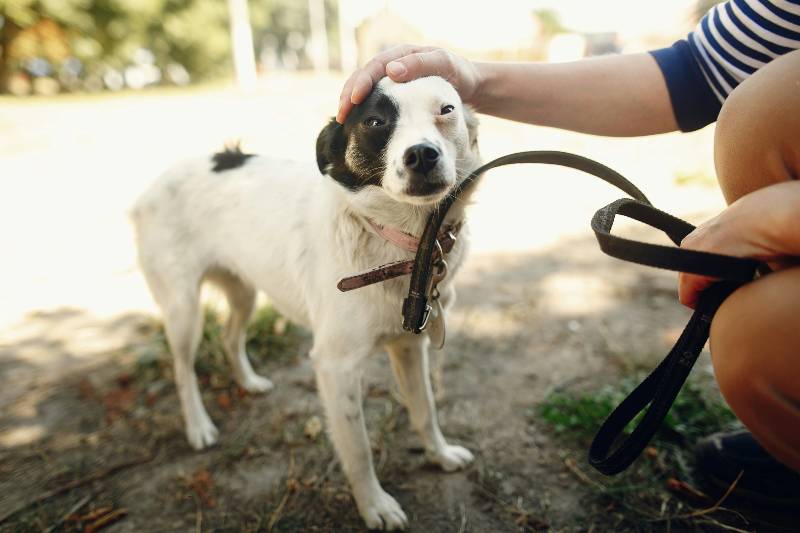As a new dog owner, spotting your dog with their tail tucked between their legs might leave you puzzled or even worried. This gesture is like a window into your dog’s feelings and thoughts.
Understanding why your dog behaves a certain way is a big step in getting to know and care for them better.
What Does Dog Tucking Their Tail Between the Legs Mean?
Seeing your dog tuck their tail isn’t just a peculiar habit; it’s a form of communication. Here are some of the emotions and intentions behind this gesture:
1. Fear
Imagine being in a situation that rattles your nerves—an unexpected loud noise, a looming stranger, or an unfamiliar place. Just like you might react by recoiling, dogs express their fear by tucking their tails.
This stance helps them appear smaller, minimizing the attention they draw from what they perceive as a threat. From thunderstorms to intimidating encounters with other animals, various scenarios could trigger this fearful response.
2. Submissiveness
In the canine kingdom, social hierarchy plays a pivotal role. By tucking their tail and sometimes even showing their belly, a dog signals submissiveness.
It’s their way of saying, “I acknowledge your authority” or “You’re the boss.” This behavior is frequently seen when dogs interact with each other but can also be directed towards humans.
In a multi-dog household, you might notice the less dominant dog showcasing this behavior more frequently as a peacekeeping gesture.
3. Avoiding Confrontation
Dogs are not always eager for a face-off. When they wish to steer clear of a potential skirmish or dispute, tucking their tail can be their white flag. It’s their manner of communicating, “I don’t want any trouble.”
This could happen during interactions with more assertive dogs, or when they’re in situations that make them uncomfortable. Understanding this signal can help you intervene and ensure a peaceful resolution before any tensions escalate.
4. Concentration
It might come as a surprise, but dogs can also tuck their tails when they’re deeply focused or working on something. It’s like when a person scrunches their eyebrows together when they’re thinking hard.
Whether they’re trying to figure out how to retrieve a toy from under the couch or focusing intently during a training session, the tucked tail can signal a high level of concentration.
What to Do When Your Dog Tucks Their Tail Between the Legs?
Noticing your dog’s tail tucked away can be a cause for concern, but recognizing it as a form of communication is the first step toward addressing their needs. Here’s how you can respond:
1. Assess the Environment
The first step is to figure out what conditions make your dog tuck their tail between their legs. So you need to look around your and your dog’s surroundings and try to identify what might cause this behavior.
If it’s an unusually loud noise, an unfamiliar setting, or the presence of strangers or other animals, understanding the trigger can help you minimize their exposure to it.
2. Offer Comfort and Reassurance
If fear is the driving force behind your dog’s behavior, offering comfort and reassurance is key. Approach them gently, using a soft tone of voice to reassure them that they’re safe.
Sometimes, physical comfort like petting or cuddling can help, but be mindful of their personal space. Some dogs might need a little room to process their fear before they seek comfort.
3. Create a Safe Space
Dogs, much like humans, appreciate having a safe, comfortable corner where they can retreat and relax. This can be especially helpful for dogs that frequently feel scared or anxious.
Whether it’s a cozy dog bed in a quiet corner of your home or a crate that they’ve been positively conditioned to see as their den, having a dedicated safe space can provide immense relief for a stressed dog.
Make sure this area is easily accessible to them at all times. Sometimes, simply knowing they have a safe retreat can help reduce their anxiety and the need to tuck their tails.
4. Training and Socialization
Engaging in regular training sessions and ensuring proper socialization can significantly reduce instances of tail-tucking due to fear, submissiveness, or the desire to avoid confrontation.
Training provides a framework of commands and behaviors that can elevate your dog’s confidence. Simple commands like sit, stay, or come can give your dog a sense of structure and security in uncertain situations.
Meanwhile, positive socialization experiences expose your dog to various stimuli – people, pets, environments – in a controlled, measured way, helping them become more adaptable and less prone to anxiety.
5. Provide Positive Reinforcement
Encouraging submissive or fear-based behavior might not be your goal, but it’s important to handle these situations with patience and positivity.
Reward your dog’s calm and confident moments with treats, praise, and affection. Positive reinforcement not only boosts their confidence but also strengthens your bond.
6. Seek Professional Guidance
Sometimes, despite your best efforts, you might find that your dog’s behavior doesn’t improve or even worsens. In such cases, consulting with a professional dog trainer or a behaviorist can offer a new perspective.
These experts can provide tailored advice and strategies based on your dog’s specific needs, personality, and the situations they find challenging.
7. Give Them Time
Patience is key when dealing with a dog that frequently exhibits tail-tucking behavior. Remember that each dog is an individual, and what works for one may not work for another. Changes in behavior can take time, and it’s essential to celebrate small progress.
Avoid forcing them into situations that clearly make them uncomfortable. Instead, gradually introduce new experiences, allowing them ample opportunity to retreat if they start to feel overwhelmed.
Conclusion
When your dog tucks its tail between their legs, it’s part of many signals they use to communicate. Pay attention to their overall body posture, facial expressions, and sounds can give you a clearer picture of their emotional state.
Every dog is unique, with their own set of experiences and personality traits that influence their behavior.
As you grow together, learning to read and respond to their specific cues, you’ll find that the bond between you and your pet deepens, leading to a more harmonious and understanding relationship.





